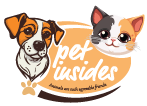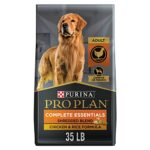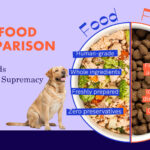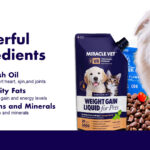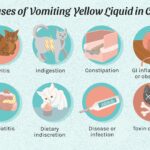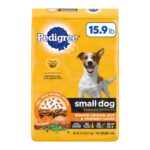Can Food Cause Anal Gland Issues in Dogs ? Vet Insights Revealed Yes, food can cause anal gland issues in dogs. Diet influences stool consistency, impacting anal gland health.
Anal gland problems are common in dogs and can be uncomfortable. Diet plays a crucial role in maintaining anal gland health. High-fiber foods help produce firm stools, which can naturally express the glands during defecation. Low-quality or low-fiber diets may lead to soft stools, causing gland impaction.
Obesity and food allergies also contribute to these issues. Feeding your dog a balanced diet with adequate fiber content helps prevent anal gland problems. Always consult your vet for dietary recommendations tailored to your dog’s specific needs. Proper diet management can significantly reduce the risk of anal gland issues and improve your dog’s overall well-being.
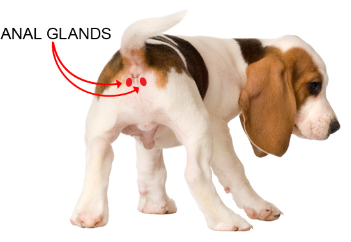
Credit: www.roseparkvet.com.au
Introduction To Anal Gland Issues In Dogs
Anal gland issues are common in dogs. These small glands can cause big problems. They are located near your dog’s anus. When they get blocked, your dog can suffer.
The Role Of Anal Glands
Anal glands produce a strong-smelling fluid. This fluid helps dogs mark their territory. It also helps with bowel movements. When the glands work well, dogs feel comfortable.
Sometimes, the glands get blocked. This can cause pain and infection. Diet can play a role in this problem.
Common Symptoms Of Problems
Dogs show symptoms when their anal glands are blocked. You might notice your dog scooting. This is when they drag their bottom on the ground. Your dog might also lick the area often.
Other symptoms include:
- Swelling around the anus
- Bad smell
- Difficulty sitting
- Discomfort during bowel movements
If you see these signs, consult your vet. Early treatment can prevent serious issues.
| Symptom | Description |
|---|---|
| Scooting | Dragging the bottom on the ground |
| Licking | Frequent licking of the anal area |
| Swelling | Visible swelling around the anus |
| Bad Smell | Foul odor from the anal area |
| Difficulty Sitting | Struggling to sit comfortably |
| Discomfort During Bowel Movements | Signs of pain when pooping |
Understanding these symptoms helps in early detection. This ensures your dog gets timely care.
“`

Credit: www.glandex.com
The Impact Of Diet On Canine Health
Dogs rely on a balanced diet for good health. The food they eat affects every part of their body. This includes their anal glands. Poor diet can lead to anal gland issues. Feeding your dog the right food is crucial. It keeps their digestive system healthy. Good nutrition helps prevent diseases. Let’s explore how diet impacts a dog’s health.
Nutritional Requirements For Dogs
Dogs need specific nutrients to stay healthy. These include:
- Proteins
- Fats
- Carbohydrates
- Vitamins
- Minerals
- Water
Proteins build and repair tissues. Fats provide energy and support cell growth. Carbohydrates are a source of energy. Vitamins and minerals are essential for various bodily functions. Water is crucial for hydration and digestion.
Feed your dog a balanced diet. It should contain all these nutrients. Quality dog food often meets these needs. Check labels for ingredients. Avoid food with fillers and artificial additives.
The Connection Between Diet And Disease
Diet plays a role in disease prevention. Poor diet can lead to various health issues. Anal gland problems are one of them. High-fat diets can cause obesity. Obesity can lead to impacted anal glands. Dogs with low-fiber diets may have loose stools. Loose stools don’t put pressure on anal glands. This can cause glands to become full and infected.
High-quality dog food can help prevent these issues. Look for food with natural ingredients. Fiber in the diet helps with stool formation. This ensures proper anal gland function.
Consider the following tips for a healthy diet:
- Choose dog food with high protein and fiber content.
- Avoid foods with artificial additives and fillers.
- Monitor your dog’s weight and adjust their diet as needed.
- Provide fresh water at all times.
A balanced diet keeps your dog healthy. It supports their overall well-being. Proper nutrition can prevent anal gland issues.
Anal Gland Disorders: A Brief Overview
Anal gland disorders can cause discomfort for dogs. These glands are small, located near the rectum. They release a unique scent when your dog poops. Problems arise when these glands get blocked or infected.
Types Of Anal Gland Disorders
There are several types of anal gland disorders:
- Impaction: Glands are blocked, causing swelling.
- Infection: Bacteria cause swelling and pain.
- Abscess: Severe infection leads to pus buildup.
Consequences Of Ignored Symptoms
Ignoring symptoms can lead to serious issues:
- Chronic Pain: Your dog may feel constant discomfort.
- Behavior Changes: Pain can make your dog irritable.
- Health Risks: Untreated infections can spread.
Understanding these disorders helps in early detection and treatment. Regular vet check-ups are crucial for your dog’s health.
Investigating The Diet-anal Gland Link
Many dog owners worry about anal gland issues. These glands can cause discomfort in dogs. Some experts believe diet plays a role. This section explores the connection between diet and anal glands.
Scientific Studies On Diet And Anal Glands
Several scientific studies explore the link between diet and anal gland issues. Researchers found some interesting patterns. A high-fiber diet can help dogs with anal gland problems. Fiber helps form firmer stools. This firmness aids in expressing the glands naturally.
Another study looked at fat content in dog food. High-fat diets may lead to softer stools. Softer stools can make it hard for the glands to empty. This can cause issues. Lowering fat intake might help some dogs.
| Diet Component | Impact on Anal Glands |
|---|---|
| High Fiber | Firmer stools, better gland expression |
| High Fat | Softer stools, potential gland issues |
Testimonies From Veterinarians
Veterinarians often see the effects of diet on anal glands. Dr. Smith from Happy Paws Clinic shares insights. She states, “A balanced diet can prevent many anal gland issues.” Dr. Lee, another vet, agrees. He says, “Fiber is key. It helps dogs express their glands naturally.”
Dr. Green has similar experiences. He mentions a case of a dog with chronic gland issues. After changing to a high-fiber diet, the dog improved. “The difference was clear,” he says. “Diet made a big impact.”
- Dr. Smith: Balanced diet prevents issues.
- Dr. Lee: Fiber helps natural expression.
- Dr. Green: High-fiber diet showed clear improvement.
Ingredients Suspected To Trigger Issues
Many dog owners are concerned about their pet’s health. One common issue is anal gland problems. Certain foods may be the cause. Understanding these triggers can help keep your dog healthy.
Problematic Foods And Additives
Some foods and additives can cause issues for dogs. Here are a few:
- Grains: Wheat, corn, and soy can be hard to digest.
- Artificial Additives: Colors, flavors, and preservatives may irritate the glands.
- Dairy Products: Many dogs are lactose intolerant.
- Fats and Oils: Too much fat can lead to gland problems.
These ingredients can cause inflammation and discomfort. Avoiding them may help your dog.
Allergens And Anal Gland Inflammation
Allergens can also play a role in anal gland issues. Common allergens include:
- Beef: Some dogs are allergic to beef protein.
- Chicken: Poultry can cause allergic reactions.
- Dairy: Milk and cheese can be problematic.
- Eggs: Egg proteins can trigger allergies.
These allergens can cause inflammation. This can lead to gland issues.
| Problematic Ingredients | Effects on Dogs |
|---|---|
| Grains (Wheat, Corn, Soy) | Hard to digest, may cause inflammation |
| Artificial Additives | May irritate glands, cause discomfort |
| Dairy Products | Lactose intolerance, potential inflammation |
| Fats and Oils | Excess fat can lead to gland issues |
| Beef | Common allergen, may cause inflammation |
| Chicken | Poultry allergens can trigger reactions |
| Eggs | Egg protein can cause allergies |
Avoiding these ingredients can help your dog stay healthy. Check food labels carefully. Choose products with simple, natural ingredients.
High-fiber Diets: A Preventive Measure?
Many dog owners worry about anal gland issues in their pets. A high-fiber diet can help prevent these problems. Fiber helps dogs produce firm stools. Firm stools can express the anal glands naturally.
Benefits Of Fiber For Anal Gland Health
Adding fiber to your dog’s diet can have several benefits:
- Fiber helps maintain proper bowel movements.
- Firm stools naturally express the anal glands.
- Fiber aids in overall digestive health.
- It helps prevent constipation and diarrhea.
- Fiber can also help with weight management.
Recommended High-fiber Foods
Here are some high-fiber foods that can benefit your dog’s anal gland health:
| Food | Fiber Content |
|---|---|
| Pumpkin | 7 grams per cup |
| Sweet Potatoes | 4 grams per cup |
| Green Beans | 4 grams per cup |
| Carrots | 3.6 grams per cup |
| Apples (without seeds) | 4 grams per apple |
Adding these foods to your dog’s diet can make a big difference. Always introduce new foods gradually to avoid stomach upset. Consult your vet before making significant changes to your dog’s diet.
The Role Of Obesity In Anal Gland Problems
Obesity in dogs is a growing concern. It can lead to many health issues. One of these is anal gland problems. Excess weight puts pressure on a dog’s anal glands. This makes it hard for them to empty naturally. As a result, your dog may suffer from discomfort and infections. Managing your dog’s weight is crucial to preventing these problems.
Weight Management And Anal Gland Function
Maintaining a healthy weight is key for your dog’s anal gland health. Obesity affects the normal function of these glands. Extra fat around the anal area adds pressure. This can make it difficult for the glands to empty. Regular exercise and a balanced diet are essential. They help in weight control and support anal gland function.
Dietary Adjustments For Weight Control
Adjusting your dog’s diet can help manage their weight. Choose high-fiber foods. Fiber helps in firming up stools. Firmer stools put pressure on the anal glands. This helps them empty naturally. Avoid high-fat and high-calorie treats. These contribute to weight gain and can worsen anal gland issues.
| Recommended Foods | Avoid |
|---|---|
| High-fiber kibble | High-fat treats |
| Lean proteins | Fatty meats |
| Vegetables | Processed snacks |
Portion control is also important. Overfeeding can lead to obesity. Follow feeding guidelines based on your dog’s size and breed. Regular vet check-ups can help monitor your dog’s weight. This ensures they stay on track with their weight management goals.
- Choose high-fiber foods
- Avoid high-fat treats
- Practice portion control
- Include regular exercise
Keeping your dog at a healthy weight can prevent anal gland issues. It also contributes to their overall well-being. Make dietary adjustments and ensure regular exercise. This helps in maintaining a healthy weight and supporting anal gland function.
Grains Or No Grains: What’s Best For Anal Glands?
Dog owners often wonder about the best diet for their furry friends. One key topic is whether grains or grain-free diets are better for their dog’s anal gland health. Let’s explore this further.
Grain-free Diets And Their Effects
Grain-free diets have become popular among pet owners. These diets replace grains with ingredients like potatoes, peas, and lentils.
- Grain-free diets can help dogs with grain allergies.
- Some believe they reduce inflammation and digestive issues.
- Grain-free diets may lead to smaller, firmer stools.
Smaller, firmer stools may help in expressing the anal glands naturally. But not all dogs benefit from a grain-free diet. Always consult with your vet before making changes.
The Debate Over Grains In Dog Food
Many experts argue that grains are not harmful to most dogs. Grains provide essential nutrients like fiber, vitamins, and minerals.
- Fiber helps in forming solid stools.
- Solid stools can help express the anal glands.
- Grains are also a source of energy and protein.
Some dogs may have grain allergies or sensitivities. These dogs might benefit from a grain-free diet. But for most dogs, grains can be a healthy part of their diet.
| Diet Type | Pros | Cons |
|---|---|---|
| Grain-Free | Reduces allergies, smaller stools | May lack essential nutrients |
| With Grains | Provides fiber, vitamins | Potential allergies |
Choosing between grains or grain-free depends on your dog’s needs. Consult with a vet to make the best decision for your pet’s anal gland health.
Probiotics And Digestive Health In Dogs
Probiotics play a vital role in a dog’s digestive health. These beneficial bacteria help maintain a balanced gut flora. A healthy gut can prevent anal gland issues in dogs. Let’s explore how probiotics improve gut flora and how to select the right probiotics for your dog.
Improving Gut Flora For Anal Gland Health
A balanced gut flora is crucial for your dog’s overall health. Good bacteria help break down food and absorb nutrients. They also keep harmful bacteria at bay. A healthy gut reduces inflammation and improves stool consistency.
Firm stools help express the anal glands naturally. Soft stools may not provide enough pressure. This can lead to anal gland issues. Probiotics support a healthy digestive system, ensuring firmer stools and better anal gland health.
- Better nutrient absorption
- Reduced inflammation
- Improved stool consistency
Selecting The Right Probiotics
Choosing the right probiotics for your dog is essential. Different strains of probiotics offer various benefits. Look for probiotics specifically designed for dogs. These strains are tailored to a dog’s digestive system.
Some common probiotic strains for dogs include:
- Lactobacillus acidophilus – Supports digestion and boosts the immune system.
- Bifidobacterium animalis – Improves stool quality and reduces diarrhea.
- Enterococcus faecium – Enhances gut health and combats harmful bacteria.
Consult your veterinarian to determine the best probiotic for your dog’s needs. They can recommend the right dosage and product.
| Probiotic Strain | Benefit |
|---|---|
| Lactobacillus acidophilus | Supports digestion and immune system |
| Bifidobacterium animalis | Improves stool quality and reduces diarrhea |
| Enterococcus faecium | Combats harmful bacteria and enhances gut health |
The Truth About Commercial Dog Foods
Many dog owners trust commercial dog foods for convenience. But these foods may have hidden risks. Some ingredients could cause anal gland issues in dogs.
Analyzing Ingredient Lists
Always check the ingredient list on dog food packages. Ingredients are listed by weight. The first few ingredients are the most important.
- Meat: Look for named meat sources like chicken or beef.
- Fillers: Avoid foods with corn, soy, or wheat as main ingredients.
- By-products: Be cautious of vague terms like “meat by-products.”
Fillers and by-products can cause digestive issues. These issues may lead to anal gland problems.
The Reality Of Marketing Claims
Marketing can be misleading. Labels like “all-natural” or “premium” don’t always mean better quality.
| Claim | Reality |
|---|---|
| Grain-free | May still contain fillers like peas or potatoes. |
| All-natural | Still can have harmful preservatives. |
| Premium | Not a regulated term. Quality varies. |
Always read beyond the marketing claims. Check the ingredient list for a clearer picture.
Choosing the right food helps prevent health issues. Your dog deserves the best.
Home-cooked Meals Vs. Store-bought: What’s Safer?
Choosing between home-cooked meals and store-bought food for your dog can be tricky. Many pet owners wonder which option is safer. This choice can impact your dog’s health, especially regarding anal gland issues.
Pros And Cons Of Home-cooked Diets
Home-cooked diets allow you to control your dog’s ingredients. This can be crucial for dogs with allergies or sensitivities.
- Pros
- Control over ingredients
- Fresh, high-quality foods
- Avoid harmful additives and preservatives
- Cons
- Time-consuming
- Requires knowledge of canine nutrition
- Potential for unbalanced meals
Balancing Nutrition With Home-cooked Meals
Balancing nutrition is key to preventing health issues like anal gland problems. A balanced diet ensures your dog gets essential nutrients.
To help balance home-cooked meals, consider these tips:
- Use a variety of protein sources
- Include vegetables and fruits
- Incorporate healthy fats
- Consult with a vet for supplements
Here’s a simple table for quick reference:
| Nutrient | Source |
|---|---|
| Protein | Chicken, beef, fish |
| Carbohydrates | Rice, sweet potatoes, oats |
| Fats | Fish oil, flaxseed oil |
| Vitamins | Leafy greens, carrots, berries |
Home-cooked meals can be a great option with proper balance. Ensure your dog gets all the nutrients they need to stay healthy.
Raw Diets: A Natural Solution For Anal Gland Woes?
Many dog owners face issues with their pets’ anal glands. Anal gland problems cause discomfort and health issues for dogs. Some believe raw diets can help. Let’s explore this trend and see its potential benefits and risks.
Examining The Raw Food Trend
Raw food diets include uncooked meat, bones, and vegetables. This diet mimics what dogs eat in the wild. Proponents claim it improves health and reduces anal gland problems. They argue that raw food is more natural for dogs.
Dogs on raw diets often have firmer stools. Firm stools put pressure on anal glands, helping them empty naturally. This reduces the risk of gland issues. Many owners report fewer vet visits for anal gland problems.
Potential Benefits And Risks
| Potential Benefits | Potential Risks |
|---|---|
|
|
Owners need to handle raw food carefully. Clean surfaces and wash hands to prevent contamination. Some dogs may have allergies or sensitivities to certain raw foods. Consult a vet before starting a raw diet.
Not all dogs will benefit from a raw diet. Each dog is unique and may respond differently. Owners should monitor their dogs closely and make adjustments as needed.
Recognizing Food Intolerances In Dogs
Recognizing Food Intolerances in Dogs is crucial for preventing anal gland issues. Food intolerances can cause various health problems, including digestive issues and skin problems. Identifying and addressing these intolerances helps keep your dog healthy and happy.
Signs Your Dog May Have A Food Intolerance
Food intolerances can manifest in different ways. Watch for these common signs:
- Chronic Ear Infections: Repeated ear infections can indicate a food problem.
- Itchy Skin: Dogs may scratch or lick their skin excessively.
- Digestive Issues: Vomiting, diarrhea, or gas can signal a food intolerance.
- Anal Gland Problems: Scooting or licking the anal area might be related to food.
- Behavioral Changes: Dogs may become irritable or lethargic.
Elimination Diets And Diagnosis
To identify food intolerances, try an elimination diet. Follow these steps:
- Choose a novel protein and carbohydrate your dog hasn’t eaten before.
- Feed your dog only this diet for 8-12 weeks.
- Monitor your dog’s symptoms for improvement.
- Gradually reintroduce other foods one at a time.
- Observe any reactions to identify problematic foods.
| Step | Action |
|---|---|
| 1 | Choose a novel protein and carbohydrate. |
| 2 | Feed only this diet for 8-12 weeks. |
| 3 | Monitor symptoms for improvement. |
| 4 | Reintroduce foods one at a time. |
| 5 | Observe reactions to identify problematic foods. |
Consult your veterinarian during this process. They can guide you and ensure your dog’s diet is balanced. An elimination diet helps pinpoint the cause of food intolerances. This can prevent anal gland issues and promote overall health.

Credit: peterdobias.com
Transitioning To A New Diet Safely
Changing your dog’s diet can help with anal gland issues. Transitioning to a new diet safely is key. A gradual change prevents digestive upset. Follow these steps to ensure a smooth transition.
Steps For Changing Your Dog’s Diet
- Start Slowly: Mix a small amount of new food with the old.
- Increase Gradually: Increase the new food amount over 7-10 days.
- Monitor for Reactions: Watch for signs of discomfort or allergies.
Monitoring Your Dog’s Response To Diet Change
Pay attention to your dog’s behavior and stool. Look for these signs:
- Normal Stool: Firm, brown, and easy to pick up.
- Increased Energy: More playful and active behavior.
- Healthy Coat: Shiny and soft fur.
If you notice any issues, consult your vet. They can offer guidance and support.
Preventive Strategies And Regular Care
Keeping your dog’s anal glands healthy is essential. Regular care and good diet prevent many issues. Here are some strategies to keep your dog’s anal glands healthy.
Routine Checks And Anal Gland Expression
Routine checks can catch problems early. Your vet can show you how to check the glands. It’s simple and quick to learn. Some dogs may need regular expression of their glands. This helps prevent blockages.
Anal gland expression can be done at home or by a vet. Doing it at home saves vet visits. Use gloves and have a helper if needed. Gently press on both sides of the anus. Release the fluid carefully.
| Step | Action |
|---|---|
| 1 | Wear gloves |
| 2 | Have a helper hold the dog |
| 3 | Gently press on each side of the anus |
| 4 | Release fluid carefully |
If unsure, always ask your vet. They can do it safely.
Long-term Diet Management For Anal Gland Health
Diet plays a big role in anal gland health. High-fiber foods can help. Fiber helps stools become firm. Firm stools press the glands, helping them empty naturally.
Consider adding these high-fiber foods to your dog’s diet:
- Pumpkin
- Green beans
- Sweet potatoes
- Carrots
Commercial dog foods also have high-fiber options. Check labels for fiber content. Aim for a balanced diet with plenty of fiber.
Here is an example of a high-fiber diet plan:
| Meal | Ingredients |
|---|---|
| Breakfast | Dog food with added pumpkin |
| Lunch | Green beans and chicken |
| Dinner | Sweet potatoes and dog food |
Always provide fresh water. Water aids digestion and keeps stools soft. Monitor your dog’s weight. Obesity can worsen anal gland issues.
Frequently Asked Questions
Can Dog Food Cause Scooting?
Yes, dog food can cause scooting. Low-quality food or food allergies may lead to digestive issues and anal gland problems.
How To Tell If Dogs’ Anal Glands Are Full?
Signs of full anal glands include scooting, licking the area, and a foul smell. Your dog may also show discomfort.
Can Diet Cause Anal Gland Issues In Dogs?
Yes, diet can impact anal gland health. A diet low in fiber may lead to softer stools, making it harder for dogs to naturally express their anal glands.
What Foods Help Prevent Anal Gland Problems?
Foods high in fiber, like pumpkin and sweet potatoes, can help firm up stools. This can make natural anal gland expression easier.
Conclusion
Diet plays a crucial role in your dog’s anal gland health. Choose high-fiber foods and avoid processed treats. Regular vet check-ups can also help prevent issues. Always consult your veterinarian for personalized advice. Keeping your dog’s diet balanced ensures their overall well-being.
Prioritize proper nutrition for a happier, healthier pet.
